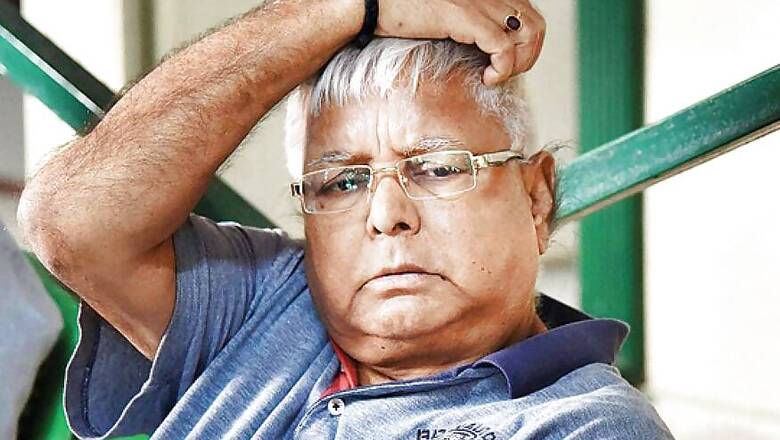
views
Faced with dissension following the Lok Sabha debacle, the Rashtriya Janata Dal (RJD) has decided to revamp the organisation and free it from the grip of the family members of its founder-president Lalu Prasad Yadav.
A churning exercise is underway to transform its image from a ‘family enterprise’ to a ‘democratic’ political organisation.
The need to democratise the party and pull it out of Lalu’s family cocoon was felt following a series of setbacks the party suffered in the last two months. The prolonged absence of his son Tejashwi Prasad Yadav from Bihar and infighting among Lalu scions caused further uneasiness among committed senior leaders and workers about the party’s existence and future.
A team of veteran leaders, led by former Union minister Raghuvansh Prasad Singh, had met the party supremo in Ranchi last week and stressed upon the need to refurbish the RJD to take on the resurgent Bharatiya Janata Party (BJP) and its allies in the 2020 Assembly polls.
It has been decided to give prominence to senior and experienced leaders in party affairs, while the politically inclined sons and daughters of Lalu would continue to function as one among the equals in the RJD.
Lalu, however, will remain its president for the next term too as the RJD constitution does not prohibit anyone from becoming the party president even after he or she has been convicted in a criminal case.
He was made the president when the party was founded in 1997 and continued to hold on to the post after his conviction in the fodder scam cases in November 2013.
The RJD patriarch is likely to take indirect command once he is out on bail. Legal and political circles expect Lalu to get bail soon as half of the pronounced punishment required for bail in fodder scam cases is likely to be completed by the end of this year.
“Lalu is the main source of sustenance for the RJD and it is the duty of everyone, including his family members, to carry forward his policies,” said senior party leader Shivanand Tiwary, who is credited with giving a political breakthrough to Lalu Yadav.
The first and foremost task before the party is to complete its organisational polls by the end of this year and elect a new and vibrant state president ahead of the crucial 2020 Assembly elections.
The RJD had earlier decided to hold the organisational polls in April next year, but the schedule has been changed. Now, the membership drive would begin from August 9 and the election for the post of national president will be held by mid-December.
The RJD has planned to expand its membership base to 75 lakh during the membership drive. “The RJD had nearly 60 lakh members, but about 50 per cent membership was not renewed. Now, we have decided to renew old members, add 15 lakh more members and set up units at booth levels,” said party spokesperson Chitranjan Gagan.
Party insiders said the present state president Ramchandra Purve is likely to be replaced by a relatively young RJD leader who can strike a balance between the old and the new generation of party leadership.
Keeping in view of the avowed social policy of the RJD, chances of a Muslim or Dalit face becoming the state president is imminent.
A prominent Dalit face and former Assembly speaker Uday Narayan Choudhary and another Dalit leader Shivchandra Ram are prominent contenders from the scheduled caste community, while senior party leader Tanveer Hassan and former deputy chairman of the Legislative Council Salim Parvez are main aspirants from the Muslim community.
In fact, the RJD has hitherto been known as the ‘private limited company’ of Lalu Prasad Yadav and his family since its inception. He created the perception to prevent the chief minister’s chair from going out of his family and thrust his wife Rabri Devi as the chief minister before going to jail in connection with the fodder scam in 1997.
She remained at the helm till 2005 and now holds the post of Leader of Opposition in the Legislative Council and party’s senior vice-president. The younger son Tejashwi Prasad Yadav is Leader of Opposition in the Legislative Assembly, while the eldest daughter, Misa Bharti, is Rajya Sabha MP. Lalu’s elder son Tej Pratap Yadav is an MLA.
At one point of time, when Lalu was the chief minister, his two brothers-in-law Sadhu Yadav and Subhash Yadav used to call the shots. While Sadhu became a Lok Sabha MP and member of both the houses of the state legislature at different points of time, Subhas was Rajya Sabha MP and member of the Legislative Council. At present, however, they do not share cordial terms with Lalu and Rabri.
The party has suffered a loss of credibility due to continued absence of Tejashwi from Bihar affairs and his non-serious approach towards party and politics. After the Lok Sabha results were announced, he was missing from the scene for two months. He surfaced in Patna and attended the Monsoon Session of the Bihar assembly for only two days.
Some senior leaders feel Tejashwi has not shown the mettle to lead the party and galvanise supporters. Of the 80-odd party MLAs, nearly 50 of them had no regular interaction with Tejashwi on party’s policies and strategies because of the presence of a coterie around him.
The dissent within the RJD had surfaced after the three-member probe committee, headed by senior leader Jagadanand Singh, held loss of trust of its core vote bank - the Yadavs and a section of the extremely backward castes (EBCs) – as main reason for the party’s defeat in the general elections.
“The RJD should now shed this family tag and transform into a well-organised party with its avowed policy of social justice, secularism and inclusive growth,” said five-term MLA Maheshwar Yadav.
At the party’s executive committee meeting held last month, Tejashwi was declared the chief ministerial candidate of the grand alliance much to the discomfiture of allies — Hindustani Awam Morcha, Rashtriya Lok Samata Party (RLSP) and Congress.
They differed saying that the chief minister would be decided once the alliance is firmed up. In fact, the Congress is seriously mulling to go it alone in the next elections, while RLSP leader Upendra Kushwaha and HAM chief Jitan Ram Manjhi nourish chief ministerial ambitions themselves.
The rebels alleged that the wrangling among the Yadav siblings for their father’s legacy has not gone down well with people and even staunch Yadav voters preferred to side with the BJP. Meanwhile, the upper castes are annoyed by the party’s opposition to giving 10 per cent quota to the economically backward among them.
The perceived void of leadership in the RJD has prompted a change in the political equations. The BJP game plan is to woo the Yadav community that constitutes nearly 16 per cent of the total population.
The elevation of Ujiyarpur MP Nityanand Rai as Union Minister of State for Home Affairs is a big gamble the BJP has played ahead of the state polls. It is believed that Rai may be projected as the next chief ministerial candidate if political equations with Nitish Kumar are affected.
The BJP is not only trying to bring the Yadavs closer, but also wooing the Koeris or Kushwahas. Together, the Yadavs and Koeris constitute 22 per cent of the total population of Bihar.
Similarly, the Janata Dal (U), led by Nitish, is luring Muslims. If the BJP and JDU plan succeeds, the existence of the RJD will be in danger.
The RJD was recognised as a national party when Lalu was railway minister at the Centre. But the tag was taken away after its poor performance in the 2009 Lok Sabha polls and 2010 Assembly elections in Bihar.
It was out on zero in Bihar in the just-concluded Lok Sabha polls. The RJD has five members in the Rajya Sabha and 79 MLAs in Bihar, besides seven MLCs. It has elected presidents in 21 states and nominated presidents in four states.
(Author is a senior journalist. Views expressed are personal.)




















Comments
0 comment